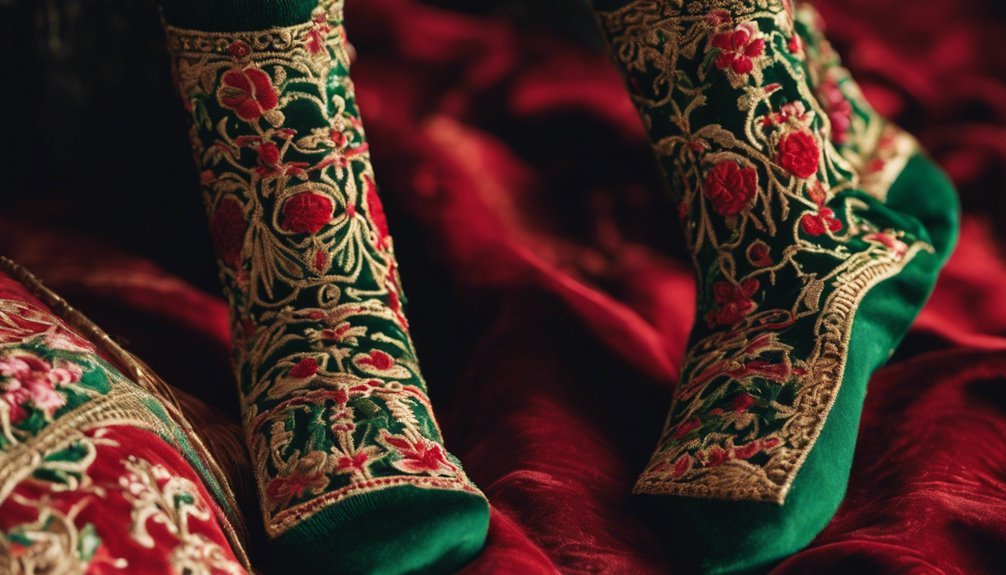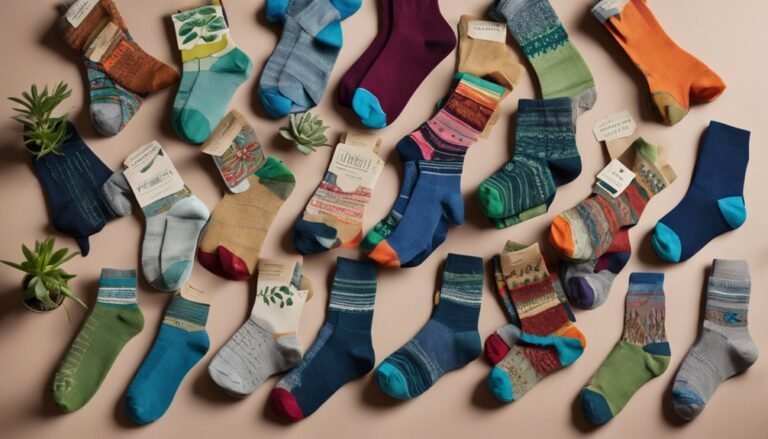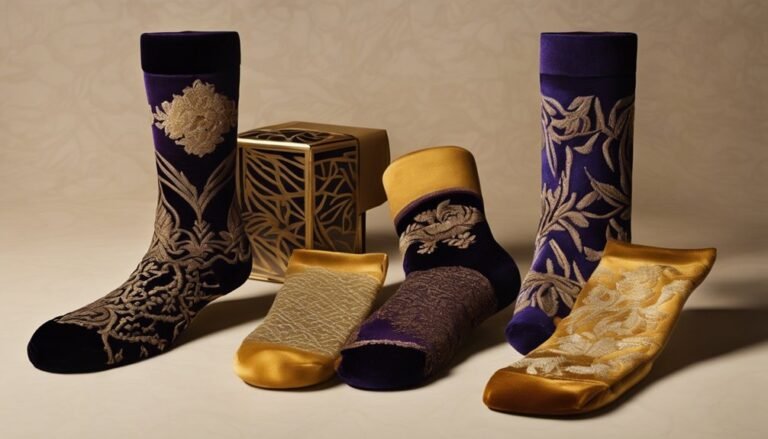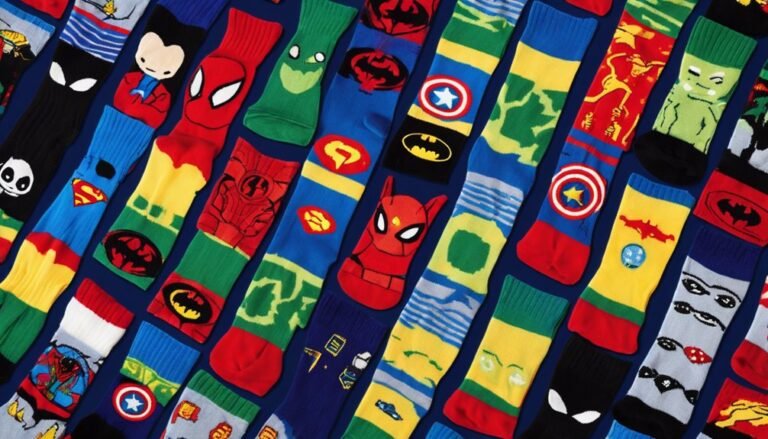Why Some Cultures Wear Specific Socks for Weddings
Have you ever noticed how certain cultures have unique traditions for weddings, including the use of specific socks? In numerous cultures, wedding socks aren't just attire; they're rich in symbolism and tradition.
These socks often signify prosperity, fertility, and protection—whether through colors, patterns, or materials. For instance, Scottish designs can showcase clan heritage, while Indian customs may use white socks for purity.
Modern brides and grooms continue to choose socks for their symbolic meanings, incorporating them into personal narratives. Exploring further reveals a fascinating interplay of cultural identity and personal expression.
Historical Roots of Wedding Socks

While wedding socks might seem like a modern trend, their historical roots reveal a deeper cultural significance. In medieval customs, socks were more than just foot coverings; they were status symbols. Richly embroidered socks displayed one's wealth and social standing, a subtle yet powerful statement at any gathering, especially weddings. These customs evolved over time, mirroring the textile evolution that brought about new fabrics and weaving techniques. As societies embraced freedom through fashion, socks became a canvas for personal expression. You might find it surprising that such a simple garment carries a legacy of tradition and innovation. From hand-knitted woolen socks of the past to today's intricate designs, wedding socks are a reflection of cultural shifts and the ever-evolving textile landscape.
Symbolic Meanings and Traditions
Although often overlooked, wedding socks carry a multitude of symbolic meanings and traditions across cultures. They're not just an accessory; they represent various aspects of wedding attire, each imbued with unique socks symbolism. In many cultures, these socks symbolize prosperity, fertility, or even protection against evil spirits. Understanding these meanings can offer you a deeper appreciation for the traditions that shape wedding ceremonies globally.
| Culture | Symbolism | Tradition |
|---|---|---|
| Japanese | Fertility | Worn during tea ceremonies |
| Scottish | Prosperity | Patterns representing clan heritage |
| Indian | Purity | White socks for pre-wedding rituals |
| Italian | Luck | Red socks for good fortune |
| Turkish | Protection | Patterns to ward off evil spirits |
Recognizing these symbols can enrich your cultural perspective, offering freedom to embrace diverse wedding attire traditions.
Regional Variations and Styles

Across the globe, wedding socks exhibit a fascinating array of regional variations and styles, each reflecting the unique cultural nuances of its origin. You'll find that these differences are shaped by historical, social, and environmental factors, offering a glimpse into the cultural influences that define a region's identity. For instance, Scandinavian wedding socks might emphasize intricate patterns and woolen materials, speaking to both their cold climate and rich textile traditions.
In contrast, Indian wedding socks often feature elaborate embroidery, reflecting the region's appreciation for detailed craftsmanship. Meanwhile, in Japan, minimalist designs might prevail, aligning with their cultural leanings towards simplicity and elegance. These regional patterns underscore how wedding socks aren't merely functional attire but also cultural artifacts, revealing the diverse ways societies express their values and heritage.
Colors and Their Cultural Significance
Examining wedding socks through the lens of regional variations naturally leads to a consideration of another important aspect: the colors chosen for these garments and their cultural significance. You'll find that color symbolism plays a vital role in many cultures, with each hue carrying specific meanings. In some traditions, red symbolizes prosperity and happiness, making it a popular choice for wedding attire. Meanwhile, white often represents purity and new beginnings, aligning with the matrimonial theme. Cultural associations can profoundly impact these selections, as they reflect deeper societal values and beliefs. For instance, in some Eastern cultures, black might be considered inauspicious, while in Western contexts, it's seen as elegant. Understanding these nuances allows you to appreciate the diversity and depth of wedding customs worldwide.
Materials and Craftsmanship in Wedding Socks

When selecting wedding socks, consider how traditional materials like silk and cotton can enhance comfort and luxury. Artisanal techniques guarantee each pair is crafted with precision, reflecting a dedication to quality that mass production often lacks. Additionally, specific designs can hold cultural symbolism, adding a meaningful touch to your wedding attire.
Traditional Sock Materials
The choice of materials in wedding socks plays an essential role in ensuring both comfort and style for the occasion. When evaluating sock fibers, you'll find that cultural preferences greatly influence the selection. In many cultures, natural fibers like silk and wool are favored for their durability and luxurious feel. Silk is often chosen for its elegant sheen and soft texture, symbolizing purity and sophistication. Wool offers warmth and resilience, ideal for colder climates or traditional ceremonies. Meanwhile, cotton is appreciated for its breathability and ease, allowing you freedom of movement. Synthetic blends may also be used for added elasticity and durability. Each material reflects not only practical considerations but also cultural values, making your selection a deeply personal and meaningful choice.
Artisanal Sock Techniques
Artisanal craftsmanship brings a unique touch to wedding socks, showcasing skilled techniques that elevate these accessories from the ordinary to the extraordinary. When you explore the world of artisanal socks, you'll discover the beauty of handcrafted patterns. These intricate designs aren't just about aesthetics; they reflect an artisan's dedication and expertise. Each stitch tells a story, intertwining tradition with individuality.
Dye techniques also play a critical role. Natural dyes, derived from plants and minerals, offer a vibrant yet subtle palette that synthetic dyes can't replicate. These methods guarantee each pair of socks is a one-of-a-kind creation. By choosing artisanal wedding socks, you're not just opting for superior craftsmanship but also embracing a piece of art that respects heritage and innovation.
Cultural Symbolism in Design
While cultural symbolism often permeates various aspects of wedding attire, it finds a unique expression in the design of wedding socks through both materials and craftsmanship. These socks aren't just about comfort; they're a canvas for cultural aesthetics. You might encounter intricate patterns that reflect a community's history or colors that symbolize prosperity and unity. The choice of materials—whether it's luxurious silk or durable wool—also speaks volumes about a culture's values and environmental influences.
Design influence plays a significant role, as artisans blend traditional motifs with contemporary trends, giving you a sense of individuality and connection to your roots. These elements collectively create a small yet profound tribute to heritage, allowing you to walk the path of tradition while embracing modern freedom.
Modern Interpretations and Innovations
Although traditional wedding attire often emphasizes formality, modern interpretations have begun to embrace individuality and innovation, particularly in the domain of socks. You might notice that contemporary couples are opting for unique sock designs that reflect personal style and broader fashion trends. This shift acknowledges the desire for expression and sustainability, as eco-friendly materials and practices become increasingly popular. New designs often incorporate organic fabrics and dyes in response to sustainable practices, marrying aesthetics with environmental consciousness. By selecting socks crafted with care for the planet, you're aligning with a movement that prioritizes both style and responsibility. These modern choices allow for a personalized touch, transforming what was once purely functional into a statement of freedom and creativity.
Personal Stories and Anecdotes
The evolution of wedding socks from a mere functional accessory to a canvas for self-expression invites a closer look into personal stories and anecdotes that highlight this trend. You find that wedding memories often intertwine with socks that reveal cultural influences or personal values. Some choose socks to honor their heritage, while others select them for individuality. Consider how they might:
- Serve as a reminder of family traditions.
- Reflect personal style or humor.
- Celebrate cultural influences through patterns or colors.
- Enhance wedding memories with customized designs.
- Symbolize unity through coordinated choices with the partner.
These choices are more than aesthetic; they're a declaration of identity and freedom, capturing the essence of a day meant to be uniquely personal and memorable.
Frequently Asked Questions
How Do Wedding Socks Impact the Comfort of the Wearer During the Ceremony?
So, you're wondering if wedding socks are foot pamperers or torture devices? Well, comfort factors hinge on sock materials. Choose wisely, or your freedom-loving feet might stage a rebellion mid-vows, demanding liberation from itchy confines.
Are There Any Superstitions Associated With Wearing Specific Socks at Weddings?
You've probably wondered if superstitions exist around wedding socks. In some cultures, sock symbolism links to prosperity and happiness. These cultural beliefs can shape perceptions, though wearing specific socks is ultimately a personal choice that promotes individual freedom.
How Do Wedding Socks Differ Between Urban and Rural Settings?
Urban sock styles often dance to the beat of contemporary trends, with sleek designs and bold colors, while rural sock traditions embrace timeless patterns and materials. You'll find modernity in cities and heritage in the countryside, reflecting cultural freedom.
What Role Do Wedding Socks Play in Intercultural or Interfaith Marriages?
In intercultural or interfaith marriages, wedding socks embody cultural symbolism and facilitate fashion integration. They allow you to express both your identities and honor traditions, promoting unity and freedom while respecting each partner's unique cultural heritage and beliefs.
How Do Economic Factors Influence the Choice of Wedding Socks?
When choosing wedding socks, your socioeconomic status can dictate options, balancing affordability and luxury. Cultural symbolism might influence your decision, as certain designs or materials reflect traditions. Consider both aspects to find socks that symbolize personal freedom and identity.







